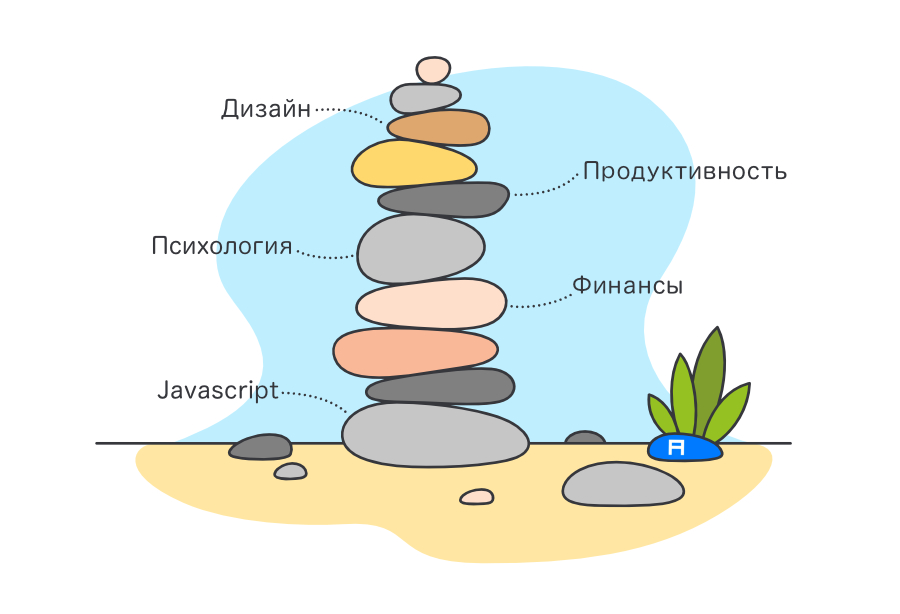
The combination of well-developed skills will make you unique, even if for each of them you are far from a genius
Let's think what it takes to become an NBA player. Most professional basketball players have been honing their skills almost from infancy. Years of endless training, training and games have helped them to develop various skills important in this sport: throws, dribbling, passes, defense and so on.
As you can imagine, the probability of becoming an NBA player is very low: there are 30 teams of 15 players each, which gives a total of about 450 people - not so much, especially when you consider that more than half a million children play youth basketball. Simple calculations show that less than one in a thousand becomes professional.
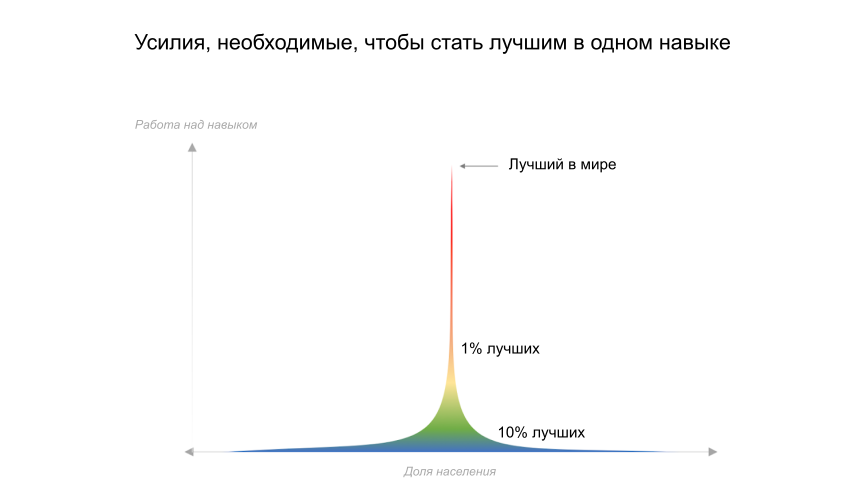
Source: Thomas Pueyo
So let's be realistic: you won’t get into the NBA, you won’t become the president, nor the greatest writer in the world, nor the best chess player, nor the most skilled speaker. You will never be the best in the world in any particular skill: there will always be someone who gives the best, who has the best genetic data, who is more lucky (or all at once).
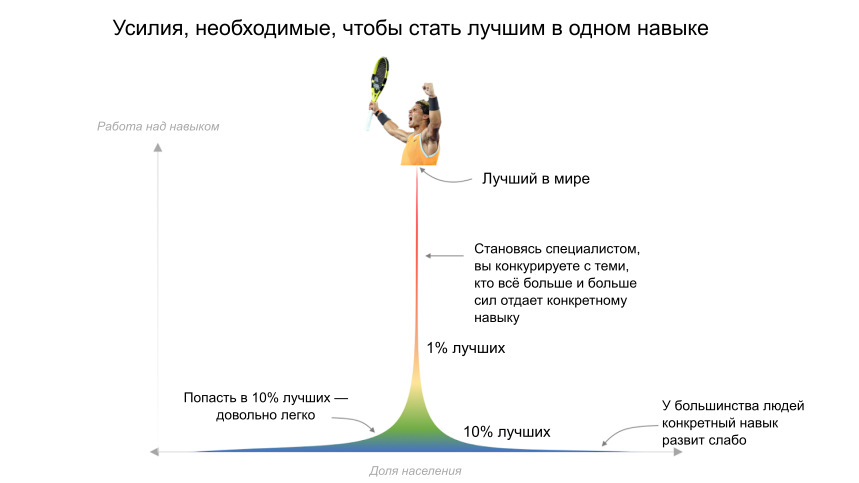
Most people (in the blue area) are poorly skilled in a particular skill. If you try a little, you will quickly fall into the 10% of the best (green area). But as soon as you join this elite, moving on becomes more and more difficult, because your competitors are more and more often people who are deeply devoted to this business.
Trying to be the best in one thing is not the smartest way to success. It is better to make an effort in mastering a combination of skills. That is, the solution is a combination of skills - a concept popularized by Scott Adams . The principle of her work is as follows.
Translated to Alconost

It’s better to have three good guns than one flawless one. The ax perfectly cuts down obstacles, but will be of little use if you need to jump over a hole. The hook is convenient for overcoming ice and pits, but is useless against the dragon. Therefore, to win, you will have to use both tools. (Illustrations - Thomas Pueyo.)
The basics
A few years ago, my friend was going to take the GMAT. He hoped to enter one of the best graduate schools, and getting a good score on this test was very important. In the first university in his list - Stanford - passed the best 6% of applicants. This meant that he was to get into the 94th percentile.
On the day of the test, my friend was very worried. He sat in front of a computer in the testing room and looked at his watch. A minute before the start. Twenty seconds. One. Zero!
It’s easier and more effective to be among the top 10% in several different skills - your “combination” - than to be among the 1% best in one thing.
Four stressful hours later, the test ended. However, it was too early to relax, because almost instantly the results appeared on the screen: the 90th percentile in the mathematical part and the 95th percentile in the language. “So I'm in the 92nd percentile?” My friend thought and was upset: the result is too low - goodbye, Stanford.
But then he took a closer look and saw that his overall result was in the 98th percentile. How so? How is this possible?
It turned out that most of those who passed the maths badly showed themselves in the language part, and vice versa. Therefore, my friend, whose score in both sections was not the best, became one of the best in terms of knowledge.
This is how combining skills works. It’s easier and more effective to be among the top 10% in several different skills - your “combination” - than to be among the 1% best in one thing. Take a look at this chart.
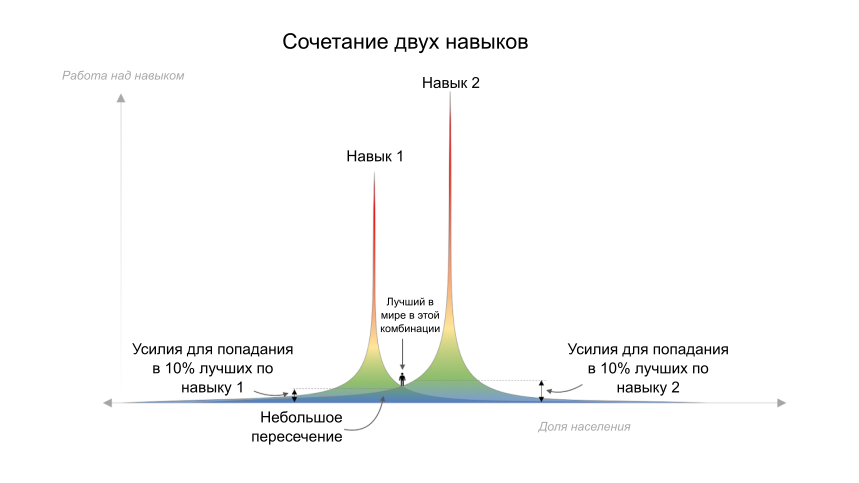
Here, each peak represents a specific skill. To get into the 10% of the best (green area) in two skills, it takes much less effort than to become the best in one. In addition, the curves intersect weakly, which means that most people who are good at one skill are not very good at another.
Let’s take a look at the numbers. For example, if a million people live in your city, and you belong to the 10% best in six skills, then this is 1,000,000 × 10% × 10% × 10% × 10% × 10% × 10% = 1 - that is, you have the best indicator in the city for a combination of six skills. But what if you increase the number of skills to ten? Then it turns out that you are the only person in the world who is well versed in all ten skills.
Ideally, skills should be rare and complementary. Imagine that someone is good enough in public speaking, raising funds, writing the text of speeches, finding the right people, managing social networks, he is charming and has the gift of persuasion. Who could it be? Of course, a successful politician: he does not need to be surprised at the level of individual skills, but it is enough to score "points" in a certain combination - and here is success!
This principle applies in all areas. Even if the prose writer is almost the best in his field, he is unlikely to achieve the same success as a person with good enough (but not the best in the world) writing prose, self-promotion, high productivity, the ability to speak and communicate personally with important people in the publishing industry.
Skill Combination Examples
Self-development guru Gary Vaynerchuk is an excellent example of combining skills: he has 5.5 million followers on Instagram, about 2 million followers on Twitter, the same number on YouTube, he runs a blog that is read as a scripture. The materials on all these channels are informative, but these are far from revelations. Vainerchuk is distinguished from the rest by a combination of skills. He doesn’t just write well: Gary can work with social networks, speak in public and develop a personal brand - and this makes him one of the best in his field.
The action of this principle can be seen on the example of Steve Jobs. At the core of his combination of skills was his passion for design, whether it was type design, packaging, or architecture. He was obsessed with the appearance and usability of his products. Jobs was never the best designer in the world, but over time he developed a deep understanding of the principles of success in design. Later, he combined various design-related skills with a deep understanding of what people want, with technical knowledge, strategic planning, the ability to interest buyers, and make the most of employee talents and entrepreneurial skills. This combination helped him create a company focused on advanced technology and attractive design.
Your unique combination of skills
Trying to determine your own winning combination of skills, you need to consider several points. Skills should be somehow connected, but should not be too similar. For example, if you are in the top 1% in journalism, getting into the top 1% in writing skills will not make much difference: most leading journalists can write well. The peculiarity of the combination is the presence of skills that not only complement each other, but are also quite different so that they can be distinguished.

Two closely related skills are shown here. Most of those who master the first are also good in the second. Therefore, it will be more difficult to stand out than if you had two unrelated skills.
It is better to choose not very strongly related skills, which, however, complement each other well. For example, techies, as you know, are usually not very good speakers, so the ability to speak publicly gives them a great professional advantage. (In statistics, this is called “covariance.” It is mathematically assumed that the skills above are completely independent.)
My path to building my own combination of skills led me to the TEDx stage - my talk was entitled “Why We Like Stories So Much”.
When I was a child, my father, who worked in advertising, tried to teach me how to be a good storyteller. I was fascinated by this topic, and now I constantly read about how to create stories. Later, I wanted to understand how everything works, and I entered a technical university. However, reading about the structure of the story, I noticed that the experts simply gave recipes, but did not explain why they should do this and not otherwise. Fortunately, thanks to my experience in developing online products, I learned a lot about psychology and design, taking into account the preferences of users, which allowed me to connect the structure of the narrative with how the brain works. Finally, ten years ago, with the help of Toastmasters, I began to study oratory - because I was afraid to speak in public.
I am one of many people in the world who have sufficient knowledge of the structure of narration, design, and psychology to establish a connection between them. But only a small fraction of these people have engineering thinking that allows them to understand how it works. And of the few who can, few are good enough speakers to talk about these theories in a speech at TEDx Talk.

This combination of skills is quite unusual: techies, as a rule, know little about design and psychology. Some designers understand psychology, but not very deeply. Few of us can speak publicly, few are good storytellers (these skills are often interconnected).
Let's roll the vertical axis and look at the chart from top to bottom.
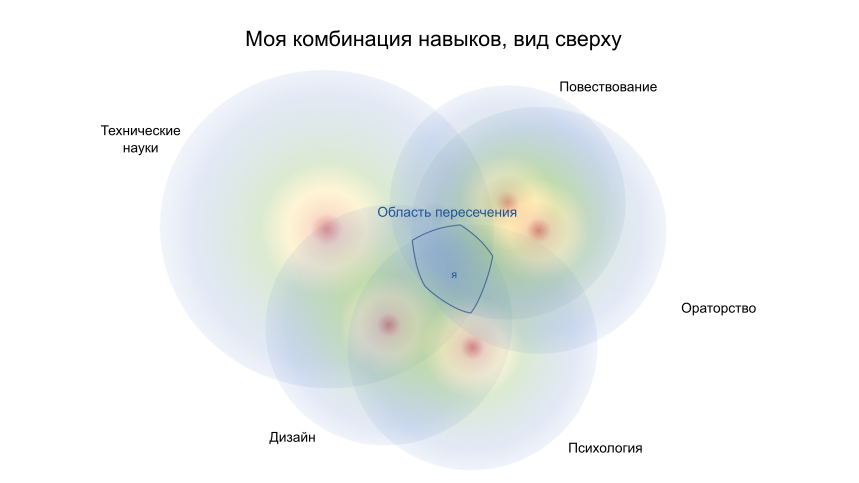
I don’t fall into the yellow-red area for any of these skills, but very few people find themselves in the intersection area.
Conclusion: do not try to become the best in one thing - most likely, in the end you will be very disappointed. Better ask yourself: “In which niche do I want to stand out? What combination of skills is needed to become unique in this niche? Do I have an interest in most - or at least some - of these skills? ”
You do not need to be great in one thing - just have a set of well-developed useful skills, the combination of which makes you unique.
About the translator
The article was translated by Alconost.
Alconost localizes games , applications and sites in 70 languages. Native translators, linguistic testing, cloud platform with API, continuous localization, project managers 24/7, any format of string resources.
We also make advertising and educational videos - for sites that sell, image, advertising, educational, teasers, expliner, trailers for Google Play and the App Store.
→ Read more